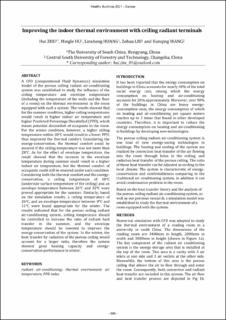| dc.description.abstract | A CFD (computational Fluid Dynamics) simulation model of the porous ceiling radiant air-conditioning system was established to study the influence of the ceiling temperature and envelope temperature (including the temperature of the walls and the floor of a room) on the thermal environment in the room equipped with such a system. The results showed that, for the summer condition, higher ceiling temperatures would result in higher indoor air temperature and higher Predicted Percentage Dissatisfied (PPD), which meant potential discomfort of occupants in the room. For the winter condition, however, a higher ceiling temperature within 28°C would result in a lower PPD, thus improved the thermal comfort. Considering the energy-conservation, the thermal comfort could be assured if the ceiling temperature was not more than 28°C. As for the effect of envelope temperature, the result showed that the increase in the envelope temperature during summer could result in a higher indoor air temperature, but the thermal comfort of occupants could still be ensured under such condition. Considering both the thermal comfort and the energyconservation, a ceiling temperature of 18°C (underside surface temperature of the ceiling) and an envelope temperature between 26°C and 32°C were proved appropriate for the summer. Similarly, based on the simulation results, a ceiling temperature of 26°C, and an envelope temperature between 8°C and 11°C were found appropriate for the winter. The results indicated that for the porous ceiling radiant air-conditioning system, ceiling temperature should be controlled to increase the ratio of radiant heat transfer in the summer, and the envelope temperature should be lowered to improve the energy-conservation of the system. In the winter, the heat transfer by radiation of the porous ceiling would account for a larger ratio, therefore the system showed good heating capacity and energyconservation performance in winter. | |

